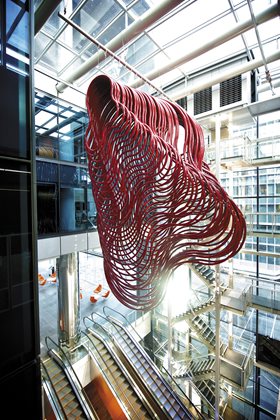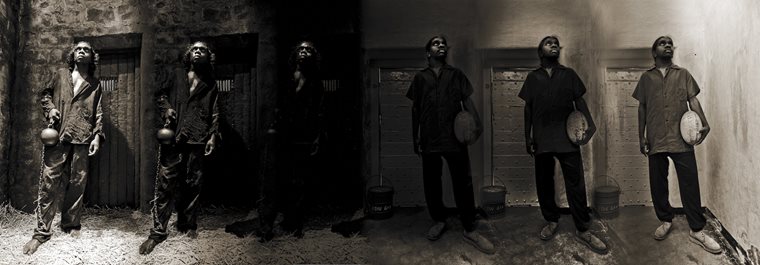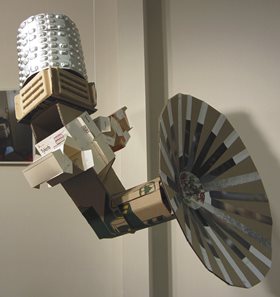 What Perth can learn from Richard Serra
What Perth can learn from Richard Serra
Commentary by Darren Jorgensen
December 2013
For years I have taken the bus along the Stirling Highway to work. At one time it was difficult to see the ocean through windows scratched into letters and obscure designs. One of my students, Jess Hutchens, argued for the qualities of these bus scratchings, and I began to look at these ephemeral, hasty compositions, rather than at the view they obscured. Jess pointed out that the windows had a transparent film that can be peeled off at the bus depot. We discussed doing an exhibition at PICA, of transparent walls of window scratching, installed like a primal maze through which people could wander. Soon, however, the campaign against bus graffiti was in full swing, Jess moved to Berlin, and my view of the ocean returned.
These window scratchers are among the few artists who have captured the imagination of the wider public. To do this, they had to be antagonistic, to confront the specular regime of cleanliness and order that drives the city’s phobia of graffiti. Behind the play of graffiti, its game of tag and run, is a more serious violation of public property. The scratching stands on that fluid border with vandalism, as it threatens to smash those clean glass surfaces that separate the passenger from the dangers at play in the world around them. How much can Perth artists take the example of bus graffiti seriously, and antagonism as a model by which to orient their own practices?
It is instructive to turn to another group of artists who are working at the other end of art practice in Perth. These are the public artists, who have ridden the crest of financial support afforded by the Western Australian government’s percent for art scheme. Tony Jones describes the way that it has enabled artists to do things they never imagined doing, like building studios, and exposed artists to the critical mass of the public.1 What has largely been missing in debates over public art, however, is this key idea of antagonism. In the US, the discourse on public art returns again and again to Richard Serra’s Tilted Arc (1981). This massive steel behemoth dissected a public square, so that people couldn’t get from work to their lunch counters without going around it. A generation of public artists were inspired by Serra’s heroism, as he bickered with architects, public officials and public alike.
Whatever you think of Serra’s work, he remains the most successful public sculptor from the US, and his contrariness is what got him there.
In Perth, the Facebook style, like or don’t like debate over James Angus’s Grow Your Own (2012) has been as close as we have got to a Serra style controversy. Here I want to turn instead to Miik Green and Brad Ladyman for a model of antagonism, who tell the story of their face off with BHP Billiton over their 2012 commission for a sculpture in the foyer of Brookfield Place. Green and Ladyman say they resisted BHP’s request to change the colour and orientation of their untitled, three ton work of twisted metal that hangs ominously above the escalators. They didn’t want to repaint it BHP orange, nor to hang it on its side so that it looked like an open cut mine. Like Frodo in Lord of the Rings, they confronted the Lords of the Tower of Mordor to emerge victorious, the great red ziggurat installed as they conceived it. Yet in terms of the overall architecture of Perth, theirs was a minor victory. Brought on board at the last minute, and slotted in above the escalators, the sculpture pales in comparison with the 46 storey skyscraper itself. The Green and Ladyman experience illustrates the way that architects, corporations, councils and governments may not know what they are asking for when they commission artwork.
Yet it can well go the other way. For example, behind the collaborative, community oriented residencies that IASKA organises across the state in its Spaced program, lie stories of artists experiencing the racism of remote Western Australia, or confronting their own racism as they attempt to incorporate Aboriginal people into their work. Of course IASKA also hosts some of the leading examples of collaboration between Aboriginal and non-Aboriginal people in the country, notably Sohan Ariel Hayes and Michael Woodley’s Birndi Wirndi/Worlds Apart (2010), a large scale projection onto the old Victoria Hotel in Roebourne. This presented the Aboriginal history of the town on the side of its most notorious site, drowning it in beer and blood. The point of this projection was not so much to reconcile historical images of this troubled town, but to affirm a history that had largely remained invisible. Hayes and Woodley created a politicised installation, destined to be seen by a particular community at a particular time, carrying with it the tensions of unresolved social antagonisms.

Racism is also the subject of much of Tania Ferrier’s work. In the exhibition Humaninside (2012) she worked closely with the Aboriginal community of the South West to document and present their experience of imprisonment. It is one of the great ironies of this region that its most distinctive art movement, the Carrolup style landscape school, produced its best work in prison. Ferrier wanted to illustrate how much this imprisonment remains a part of local Aboriginal lives, as Western Australia imprisons more Aboriginal people per head than any other state in the country. Again, the work was not fated for the public at large, but ended up being appreciated by those most affected.
The prominent theorists of antagonism in art, Claire Bishop and Suzanne Lacy, argue that art plays its most important role when it divides the community, and reveals the frictions at work beneath democracy.2
Yet in Australia it is more often the case that art is destined for an elite audience, or a specific community, and fails to shape the larger discourse of the country it is in.
When it does become a part of the public sphere and is taken up by the corporate media, government or police, it reveals the inexperience of artists, academics, arts bureaucrats and gallerists alike in engaging with debates that take place beyond the artworld. Art’s supporters generally fall back upon two overworked defences. The first is a moral defence, that art is good in and of itself, and in being good must therefore be good for society. The second is an exceptional defence, that claims for art a privileged space that suspends codes of social behaviour. The arguments are mutually exclusive, as the exception is not in the public good. The first appears over and over again in Perth in debates over everything from studio space in Fremantle to threats to state funding of the arts. The second appears more in national debates, as newspapers report on photographs of naked children or the appropriation of Aboriginal identities.
It is time that the Australian artworld argued the importance of art being used antagonistically. It is also time that the artworld learned to use the media more effectively for its own ends, and learned how to be a part of public discourse without being persecuted by it. Examples abound from the long history of Aboriginal activism, as to how art can play a role in shaping public consciousness. A first example is from 1988, when activist Ken Gilbert called Michael Nelson Tjakamarra’s mural in front of the new Parliament House a curse upon Australia. Upset at Gilbert’s stunt, Nelson held a press conference to say that its meaning was the very opposite, that it was designed to bring Australians together. The multivalence of the mural, its very ambiguity, enabled the exchange, as did Gilbert’s long experience in manipulating the media. A second example from 1997 is a local one, as the international press reported that activist Ken Colbung had declared that Princess Diana’s death was revenge for Noongar freedom fighter Yagan’s own death at the hands of English colonists.
Such stunts circle back upon the conditions by which the media constructs the public discourse. Yet the trend to argue art’s relevance to public politics has recently been reversed by one of the world’s most cited current thinkers on art, French philosopher Jacques Ranciere. A survivor of the post-structural and politicised French student movement of the 1960s, Ranciere thinks that the politics of art lies less in what it presents than in how it presents itself. So the poetics of an artwork, its aesthetics, contains within itself a kind of politics, as it configures a new way of looking at something. Ranciere’s examples are the video and photography of borders, that emphasise not the geopolitics by which the border is instituted, but the gaze upon wire fences and exchanges at smaller checkpoints that make up a personal experience of border politics.3 Art is not about news stories and billboards, then, as artist-activists imagined it to be in the 1980s, but becomes political by renouncing its heroic role, and reconstructing the conditions for seeing itself. Ranciere’s is ultimately a conservative argument, as it brings us back to an intimate encounter with art itself, rather than with art’s potential to announce a revolution of one kind or another.
 Let’s take a local example to see how this argument plays itself out. At an exhibition of self-portraits at the Mundaring Arts Centre in 2012, Carol Wells exhibited a cardboard model of a space satellite hanging from the ceiling. Behind it on the wall was a photograph of a photograph of Wells sick in bed. The cardboard was taken from the boxes and wrappers of old exhibition catalogues, pharmaceuticals and wines. Wells peers out of her photograph at this assemblage of chemical traces, as if she is contemplating the biology of her being. It is a brutally honest work, and especially haunting when you realise that the drugs named on the boxes are those used by cancer patients. Among the self-portraits at this exhibition, Wells’ work was the one that Ranciere would have liked, because it did the most to make visible what he calls the distribution of the sensible, the regimes that make up our everyday lives. Wells is stranded between the various regimes that make up her life, from alcohol to exhibitions to medicines, that constitute in this work an aesthetic picture of isolation, as she orbits her own image. To create an aesthetic out of the detritus of this isolation is to politicise this image, to speak back to the way that society reflects upon the bodies that constitute its ideas. Wells sadly died earlier this year.
Let’s take a local example to see how this argument plays itself out. At an exhibition of self-portraits at the Mundaring Arts Centre in 2012, Carol Wells exhibited a cardboard model of a space satellite hanging from the ceiling. Behind it on the wall was a photograph of a photograph of Wells sick in bed. The cardboard was taken from the boxes and wrappers of old exhibition catalogues, pharmaceuticals and wines. Wells peers out of her photograph at this assemblage of chemical traces, as if she is contemplating the biology of her being. It is a brutally honest work, and especially haunting when you realise that the drugs named on the boxes are those used by cancer patients. Among the self-portraits at this exhibition, Wells’ work was the one that Ranciere would have liked, because it did the most to make visible what he calls the distribution of the sensible, the regimes that make up our everyday lives. Wells is stranded between the various regimes that make up her life, from alcohol to exhibitions to medicines, that constitute in this work an aesthetic picture of isolation, as she orbits her own image. To create an aesthetic out of the detritus of this isolation is to politicise this image, to speak back to the way that society reflects upon the bodies that constitute its ideas. Wells sadly died earlier this year.
International conversations about the way art shapes public discourse can inform ongoing, local arguments about art in Perth. Older arguments are not performing well in an age of corporate, cultural and technological convergence. New arguments for art are needed today more than ever, but these arguments also need an art that is, in the parlance of this international conversation, antagonistic, or at the very least poetically political in Ranciere’s sense. Perth artists will remain indefensible if they do not take up a strong politics in the first place, a commitment to engaging with the brutalities that constitute the city beneath the shine.
-
1 Tony Jones interviewed in ‘Western Australia’s art industry strikes gold’ at <http://www.abc.net.au/7.30/content/2012/s3407149.htm>
-
2 Claire Bishop, ‘Antagonism and Relational Aesthetics’, October 110 (4): 51-97; Susanne Lacy, ‘Preface/Introduction: Cultural Pilgrimages and Metaphoric Journeys’ in Mapping the Terrain: New Genre Public Art, ed. S. Lacy. Seattle: Bay Press, 1995. pp. 1-49.
-
3 See Jacques Ranciere, Dissensus: On Politics and Aesthetics. Trans. Steven Corcoran. London: Continuum, 2010. pp. 149-151.
Darren Jorgensen lectures in art history at the University of Western Australia. His most recent essays on West Australian art and exhibitions are in the book, Making Worlds: Art and Science Fiction and Arena magazine.
This article featured in the Artsource Newsletter, Summer 2013/14.